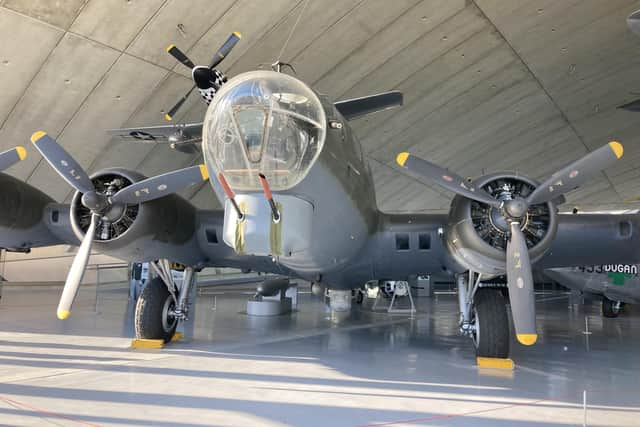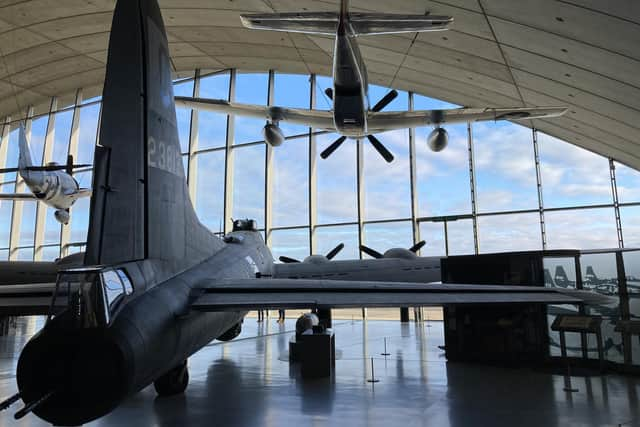Masters of the Air: Discovering the real-life stories behind latest Tom Hanks and Steven Spielberg epic
No-one can deny the massive contribution that US airmen made during the Second World War, taking huge hits in their front-line action from 1942 onwards. On Friday, an eight-part TV series, Masters of the Air, comes on stream in the form of Apple TV’s $200m blockbuster drama co-directed by the film world’s dream ticket of actor Tom Hanks and director Steven Spielberg.
Their latest war-based series is testimony to the bomber crews of the ‘Mighty Eighth’ US Airforce who were based in eastern England, including the Cambridge area.
Advertisement
Hide AdAdvertisement
Hide AdMasters of the Air follows the successful collaboration of Hanks and Spielberg in the film Saving Private Ryan; the TV streaming of Band of Brothers; and their other wartime epic The Pacific.


Visiting some of the UK locations where the youthful American heroes of Masters of the Air were based is a fascinating experience.
Two or three nights in the university city of Cambridge, a jewel in its own right, gives you the chance to get to grips with the essence of this latest production.
In all, 350,000 ‘Yanks’ were based in eastern England, often at out-of-the-way airfields, where up to 2,500 men would massively outnumber local village populations. Locals still have great affection for the Americans, and are the first to spell out the stark attrition rate of the ‘Mighty Eighth’ servicemen who went on daytime bombing raids into Hitler’s well-defended German heartland.
Advertisement
Hide AdAdvertisement
Hide AdMore than 26,000 of the Eighth Airforce men were killed in little over two years of frightening action. Another 28,000 Americans were held as prisoners of war, and there were 47,000 casualties.


The American bomber crews shared RAF Duxford with the British, and are still celebrated as being part of ‘the friendly invasion’. The base, just a few miles south of Cambridge itself, is now the home of Britain’s Imperial War Museum, which puts on spectacular flying exhibitions using heritage wartime planes.
In stark contrast, little Bottisham Airfield, a few miles north east of Cambridge, has a wonderful little museum run by local volunteers, as well as an American Mustang fighter plane, and a 1943 American Jeep that offers visitors rides.
In Duxford’s stylish American Hangar, designed by architect Norman Foster, you’re overwhelmed by the size of the US Airforce bomber aircraft on display. The ten-crew B17 Flying Fortress was used to target specific factories, munition stores and railway junctions in Germany from 1943 onwards.
Advertisement
Hide AdAdvertisement
Hide AdCurator Hattie Hearn explains: “Daytime raids were essential for such precision bombing. But until the American Mustang fighter plane was developed - in 119 days flat - the US bombers had no protection. The Spitfire was magnificent but its low fuel range meant they had to turn back over France. The Mustang changed all that.”
Bottisham Airfield volunteer Jason Webb added: “Gradually, the Allies got it right. The Mustang’s American engine was replaced by Britain’s Rolls Royce Merlin engine, which gave it the capability of being effective at over 15,000 feet, like the Spitfire. In addition, extra fuel ‘drop tanks’ were added to the Mustang, and that meant they could fly the 1400-mile return journeys into Germany to protect the precision daytime bombers from German fighter planes.
“That made all the difference. Luftwaffe Chief Herman Goering is reported to have said: ‘When I saw Mustang fighter planes over Berlin, I knew the jig was up.’ “
All this is highlighted in Masters of the Air , focusing on the American contribution, which complemented the British night time bombing raids, using home-developed Lancaster, Wellington, Blenheim, Sterling and Mosquito aircraft.
Advertisement
Hide AdAdvertisement
Hide AdBoth British and American crews mixed socially in Cambridge city centre’s Eagle pub, where they wrote their names, squadron numbers and other doodles onto the ceiling of the rear bar. They were covered by a false ceiling but revealed again in the early 1990s, and remain as testimony to the Allied troops.
More poignantly, the free-to-visit Cambridge American Cemetery and Memorial honours the dead, with nearly 4,000 graves and remembrance of 5,000 missing souls.
While in Cambridge, you should savour this historic university city, and it seems appropriate to stay at the aptly-named Graduate Hotel. This charming boutique establishment is situated right on the River Cam, where you can take a punt from just outside. Forgive me, but you’re in ‘pole’ position to view the historic colleges along the banks; take in Evensong at King’s College; stroll round the wonderful market place, or shop in the adjacent modern shopping centre.
Good eating places abound, but the food at the Graduate’s Garden Room Restaurant, the nearby Cambridge Chop House, and the Eagle is up with the best.
Advertisement
Hide AdAdvertisement
Hide AdIt’s a vibrant city, and one that shows a sense of gratitude to the American presence when Britain was up against it. At the time, many British servicemen felt ‘under fed, under paid and under Eisenhower’.
It’s also a fact that thousands of British women did marry Americans and went off to live in ‘the land of plenty’.
But without the Americans, we would not have defeated Germany and Japan. For that, the folk of the Fens are truly grateful.
International War Museum Duxford - imw.org.uk; bottishamairfieldmuseum.co.uk; Cambridge American Cemetery and Memorial - abmc.gov; graduatehotels.com; Eagle pub - greeneking.co.uk; cambridgechophouse.co.uk
Watch Masters of the Air on Apple TV from January 26.
Comment Guidelines
National World encourages reader discussion on our stories. User feedback, insights and back-and-forth exchanges add a rich layer of context to reporting. Please review our Community Guidelines before commenting.